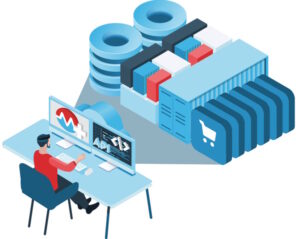An Intellyx BrainBlog by Jason Bloomberg, for Morpheus Data
The common theme across the first generation of cloud management platforms (CMPs) was command and control. The cloud operations (CloudOps) team used CMPs to keep the lights on while sticking to the budget, turning various knobs as needed to ensure their organization’s cloud infrastructure kept humming along.
What’s good for CloudOps, however, isn’t necessarily best for developers. The old days when dev would throw code over the wall to ops are long gone. Today, developers require tooling that enables them to work hand-in-hand with ops as they develop and deploy the software so essential to the business.
First-generation CMPs, however, fall short. Such platforms provide a central control point and source of truth for CloudOps but lack the features that support the developer experience necessary for modern software. Additionally, the increasingly heterogeneous nature of IT has meant hypervisor or cloud-specific tools have driven the need for a more agnostic approach than these early CMPs provided.
From Command and Control to Cacophony and Chaos
 The opposite extreme from CMP’s ops-focused command and control are the loose assemblages of development and CI/CD tools we call the DevOps toolchain.
The opposite extreme from CMP’s ops-focused command and control are the loose assemblages of development and CI/CD tools we call the DevOps toolchain.
DevOps toolchains vary from one development shop to another, and often within large shops as well from project to project. Take some Git-based tool, add one or more infrastructure-as-code products, mix in some value stream management, and top it off with deployment tools. Voila! You have a DevOps toolchain.
These toolchains have one primary benefit: flexibility. Members of the development team can pick and choose the tools they want to use, ideally empowering them to achieve greater levels of productivity and job satisfaction.
However, such flexibility comes at a cost. Toolchains can be brittle, expensive to maintain, and lack the governance policy that enterprises demand.
Organizations thus face a dilemma. Legacy CMPs offer command and control without developer flexibility, while DevOps toolchains bring flexibility to the table at the expense of increased complexity and risk. The solution is somewhere in the middle: platform engineering.
Platform Engineering: Paving the Road to Hybrid Cloud and DevOps Best Practices
Platform engineering seeks to balance two conflicting priorities: the self-service capabilities that give developers the flexibility they require, while supporting the automated operations and rigor necessary to meet the organization’s cloud management needs.
The goal of a platform engineering team is to enable product and development groups to move faster via an internal developer platform (IDP) that provides a curated set of tools, capabilities, policies, and processes as a single, coordinated framework architected for self-service.
Platform engineering is the discipline of building such a framework that supports the DevOps toolchain requirements while also enabling the enforcement of policy controls in a way that is sustainable for the organization.
Such practices, however, should never be written in stone…
– Read the whole story at the Morpheus Data blog here: https://morpheusdata.com/cloud-blog/bringing-devops-and-cloudops-together/
Copyright © Intellyx LLC. Morpheus is an Intellyx customer. Intellyx retains final editorial control of this article. No AI was used in writing this article. Image source: Morpheus



